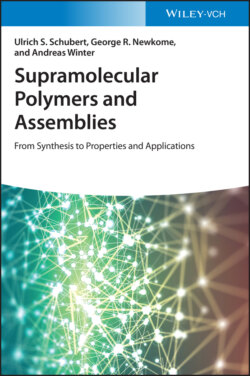Читать книгу Supramolecular Polymers and Assemblies - Andreas Winter - Страница 12
1 Supramolecular Polymers: General Considerations* 1.1 Introduction
ОглавлениеIn 1920, Staudinger proposed that polymers are indeed long chains built from repeating molecular subunits (the so‐called monomer), which are linked by covalent bonds [1]. Only a few years later, Carothers developed a classification of macromolecules taking into account both types of compounds that one can polymerize and the polymerization techniques themselves [2]. About 80 years later, this classification is still contemporary and widely utilized to explain the differences between macromolecules made via different polymerization mechanisms (e.g. step‐/chain‐growth or ring‐opening polymerization [ROP]). A broad range of polymers has been prepared over the last few decades, generally following these three basic mechanisms. More recently, the actual controlled/living techniques have widened the synthetic toolbox, but nevertheless, these metathesis, ionic, and radical polymerizations obey Carothers' taxonomy.
The interactions of macromolecules on the molecular level give rise to the materials' properties on the macroscopic scale. Such secondary or non‐covalent interactions, commonly referred to as supramolecular interactions, are responsible for the programmed function of natural (e.g. DNA and enzymes) as well as synthetic polymers [3–20]. Moreover, the emerging field of supramolecular chemistry gave answers to the question if covalently linked macromolecules are necessarily required to generate polymeric materials. Considering a supramolecular polymer, i.e. a polymer whose monomeric building blocks are connected by directional and reversible non‐covalent bonds, the field of polymer chemistry is no longer limited to conventional (i.e. covalent) macromolecules. The self‐assembly of appropriate monomers via moderately strong, reversible, and highly directional non‐covalent interactions into linear polymers of high molar mass is known as supramolecular polymerization.
The field of supramolecular chemistry was pioneered by Cram, Pedersen, and Lehn, who received the Nobel prize in chemistry in 1987 for their fundamental and groundbreaking studies in this respect. Today, supramolecular chemistry also deals with the formation of larger entities that are beyond the classical molecular covalent chemistry but still involve intermolecular non‐covalent interactions [21–23]. Several types of weak interactions are known that can keep the whole assembly together: metal‐to‐ligand coordination, hydrogen‐bonding (H‐bonding), halogen‐bonding (X‐bonding), ionic interactions, π–π‐stacking interactions, and host–guest complexation. In principle, two different types of these assemblies can be distinguished: (i) supermolecules, which are well‐defined oligomeric structures and (ii) polymolecular assemblies, which consist of a large number of monomeric species. The latter could be covalent molecules, even macromolecules [24]. Therefore, it is apparently difficult to precisely define supramolecular polymers. If the only criterion is that a supramolecular polymer “consists of non‐covalently linked monomers,” polymeric micelles, even a simple crystal formed by an organic compound, would already be a “supramolecular polymer” [25]. In contrast, Meijer and coworkers coined a new definition [26, 27]: “Supramolecular polymers are defined as polymeric arrays of monomeric units that are brought together by reversible and highly directional secondary interactions, resulting in polymeric properties in dilute and concentrated solution as well as in the bulk. The directionality and strength of the supramolecular bonding are important features of systems that can be regarded as polymers and that behave according to well‐established theories of polymer physics.”
In simple terms, a long sequence of units (i.e. monomers or polymers) connected by secondary (non‐covalent) interactions can be considered as a supramolecular polymer when the overall (macromolecular) structure can also exist in solution or in the melt (Figure 1.1) [28]. The covalent counterparts of the depicted supramolecular polymers are macromolecules, which are formed by polyaddition and polycondensation reactions, respectively.
Figure 1.1 Schematic representation of a polymer based on non‐covalent interactions.
